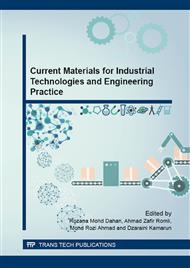[1]
X. Hao and Y. Lu, Dyeing Properties of Tussah Silk Fabric with Indigo Naturalis and Tumeric, Adv. Mater. Res., vol. 331, p.352–355, (2011).
DOI: 10.4028/www.scientific.net/amr.331.352
Google Scholar
[2]
N. Rungruangkitkrai and R. Mongkholrattanasit, Eco-Friendly of Textiles Dyeing and Printing with Natural Dyes, in RMUTP International Conference: Textile & Fashion 2012, p.1–17, (2012).
Google Scholar
[3]
A. Haji, Antibacterial Dyeing of Wool with Natural Cationic Dye Using Metal Mordants, Mater. Sci., vol. 18, no. 3, p.267–270, (2012).
DOI: 10.5755/j01.ms.18.3.2437
Google Scholar
[4]
D. Bajpai and P. S. Vankar, Antifingal Textile Dyeing with Mahonia napaulensis D.C. Leaves Extract Based on Its Antifungal Activity, Fibers Polym., vol. 8, no. 5, p.487–494, (2007).
DOI: 10.1007/bf02875870
Google Scholar
[5]
M. Mirjalili and M. Abbasipour, Comparison Between Antibacterial activity of Some Natural Dyes and Silver Nanopacticles, J. Nanostructure Chem., vol. 3, no. 1, p.37, (2013).
DOI: 10.1186/2193-8865-3-37
Google Scholar
[6]
S. J. Kadolph and K. D. Casselman, In the Bag: Contact Natural Dyes, Cloth. Text. Res. J., vol. 22, no. 1–2, p.15–21, Jan. (2004).
Google Scholar
[7]
K. D. Casselman, Lichen Dyes and Dyeing: A Critical Bibliography of the Europe and North American Literature in a Culturally Marginalized Field, (1999).
Google Scholar
[8]
D. K. Upreti, P. K. Divakar, and S. Nayaka, Commercial and Ethnic Use of Lichens in India, Econ. Bot., vol. 59, no. 436, p.269–273, (2005).
DOI: 10.1663/0013-0001(2005)059[0269:caeuol]2.0.co;2
Google Scholar
[9]
L. Din, G. Ismail, and, J. A. Elix, The Lichens in Bario Highlands: Their Natural Occurance and Secondary Etabolites, Biodivers. Environ. Conserv., vol. 1, no. 6, (1999).
Google Scholar
[10]
J. J. M. Sipman, Lichen of Mount Kinabalu, Trop. Btyology, vol. 8, p.281–314, (1993).
Google Scholar
[11]
L. B. Din, Z. Zakaria, M. W. Samsudin, J. A. Elix, Chemical Profile of Compounds from Lichens of Bukit Larut, Peninsular Malaysia, Sains Malaysiana, vol. 39, no. 6, p.901–908, (2010).
Google Scholar
[12]
M. Mokhtar, L. Din, N. A. M. Lazim, R. I .R. Uzir, R. Idris, and Y. Othman, Determination of Trace Elements in Malaysian Lichens as Potential Indicators for Pollution by Using Inductive Couple Plasma Emission Spectrophotometry, Malaysia J. Anal. Sci., vol. 10, p.185–188, (2006).
Google Scholar
[13]
S. Zulkifly, Y. S. Kim, M. A. Majid, and A. F. Merican, Distribution of Lichen Flora at Different Altitudes of Gunung Machincang, Langkawi Island, Malaysia, Sains Malaysiana, vol. 40, no. 11, p.1201–1208, (2011).
Google Scholar
[14]
N. A. Mohamed, W. Y. W. Ahmad, K. Ngalib, M. R. Ahmad, M. I. A. Kadir, and A. Ismail, Dyeing of Silk Fabric with Natural Dyes from Lichen Using Ultrasound Assisted Extraction, in Proceeding of IEEE Symposium on Humanities, Science and Engineering (SHUSER 2013), (2013).
Google Scholar
[15]
N. A. Mohamed, W. Y. W. Ahmad, K. Ngalib, M. R. Ahmad, M. I. A. Kadir, and A. Ismail, Microwave-Enzyme-Assisted Extraction and Dyeing of Lichen Species: Parmotrema praesorediosum, in Proceedings of the International Colloquium in Textile Engineering, Fashion, Apparel and Design 2014 (ICTEFAD 2014), p.89–93, (2014).
DOI: 10.1007/978-981-287-011-7_16
Google Scholar
[16]
A. Kumar and P. Agarwal, Dyeing of Jute with Binary Mixtures of Jackfruit Wood and Other Natural Dyes- Study on Color Performance and Dye Compatibility, Indian J. Fiber Text. Res., vol. 33, p.171–180, (2008).
Google Scholar
[17]
M. Yusuf, M. Shahid, M. I. Khan, S. A. Khan, M. A. Khan, and F. Mohammad, Dyeing Studies with Henna and Madder: A Research on Effect of Tin (II) Chloride Mordant, J. Saudi Chem. Soc., vol. 19, pp.64-72, (2011).
DOI: 10.1016/j.jscs.2011.12.020
Google Scholar


